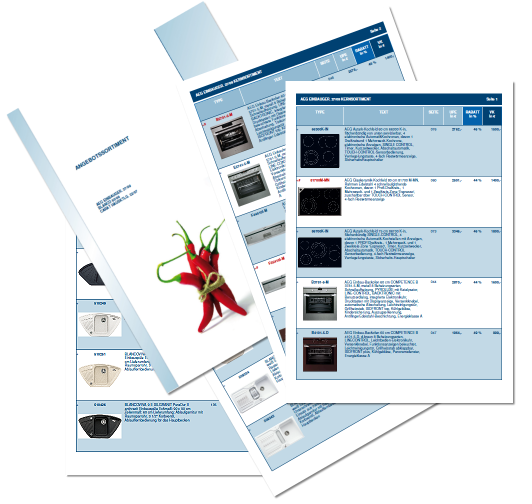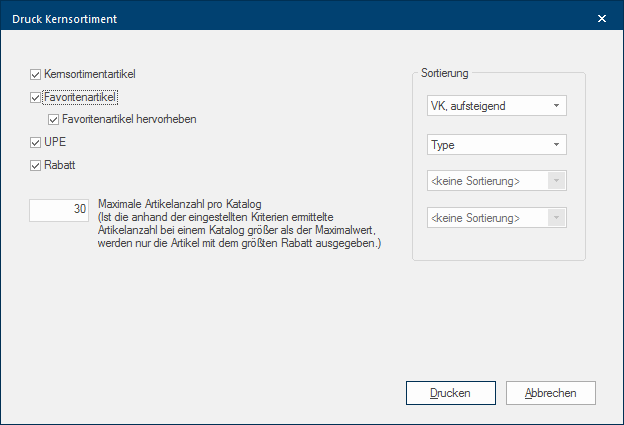The core range printing
For you to fulfil the design desires of your customers in the best possible way, your have via your suppliers access to a very large variety of articles. In order to be able to quickly and specifically prepare a quotation, you have beyond that, the availability from many suppliers, of a core range with special price advantages, or you have prepared a list of articles as your own favourites.
With the module Module 2K - Print Core Range CARAT offers you the ability to print out a manufacturers comprehensive list of those articles marked as core range or favourite articles in the article master data Head data in CARAT is the generic term for all details that are needed for the design and ordering of a kitchen. This is for example, the selected program or variations in carcase versions, or worktop edge., appealingly designed for use in sales. As an example, we have created a core range list as a PDF The Adobe Portable Document Format (PDF) was developed and perfected in the 80's by Adobe Systems. Adobe PDF files contain data from any application, that can be displayed on every computer, and are suitable thereby to be exchanged with users throughout the world.. To view the example, please click Typically the LEFT mouse button is pressed once quickly, if not specified differently. Clicking will either mark an object, or when clicking on a button, the execution of the desired activity (e.g. OK, Cancel, Close). here...
The list consists of a cover page, which if desired can be custom created to your wishes, a type listing including an image (if available), a short article description, a catalogue page, the selling price with recommended retail price (RRP) if desired, as well as a discount statement. This functionality gives you a simple and effective tool to purposefully create your own sales documents.
- Open the administration of the catalogue data by selecting the option The word option (from Latin: optio = free will) used in computing means a choice. In CARAT it is normally used with a list box. Catalogue data on the index card Some dialogue windows are too voluminous, therefore the functions are separated into indexed groups. The subgroup names typically appear on the tab of the index card at the top of the dialogue and can be selected by clicking on the appropriate tab. Data in the menu ribbon.
- Mark then with the left mouse button In dialogue windows you always find one or more buttons that can be activated by clicking on them. Typical functions for buttons are e.g. OK, Cancel, Apply. Buttons are always activated by a single click with the left mouse button. the catalogue versions Due to modifications to a yearly catalogue more than one following variation of a catalogue can be given. This is called catalogue version. that you want to print in the overview of the catalogue data. It is also possible to select catalogues from multiple suppliers, so you can sum up all core range or favourite articles from the selected catalogues in one single document. If you want to mark more than one catalogue, please hold down the Ctrl-key The Ctrl-key (short for Control Key) is located on the PC keyboard to the far left in the bottom row of keys. The Ctrl-key has a similar function as the Shift-key. Usually this key is used in conjunction with another key or with the mouse to perform a special function. and then mark the desired catalogue versions with the left mouse button.
- After you have marked one or all necessary catalogue versions, please click on the Print button in the Core Range area at the bottom.
- Thereupon, the Print core range dialogue Dialogue, dialogue windows or dialogue fields are special windows in software applications. Dialogue windows are displayed by application programs in different situations to request input or confirmation from the user. opens. There you have now the possibility to specify whether the core range and/or also the favourite articles should be printed from the previously marked catalogue(s). For the favourite articles, you can also specify whether the favourite article name should be accentuated by printing it in colour, for faster location.
- In addition Addition (in Latin: addere) is one of four basic operations in arithmetic. In primary school and in common language it is the expression used for the adding of two or more numbers., you can also display a column with the recommended retail price (RRP) and the price advantage as discount (in percentage), to better recognize the respective savings. For this, simply activate or deactivate the relevant checkbox A checkbox is a standard element in a graphic user interface. A checkbox has, in most cases, two states (set or not set). These usually correspond to a yes/no selection.. In addition, you can limit the number of articles per catalogue to be printed, if necessary.
- If you have made all your settings, start printing the list by clicking on the Print button.






